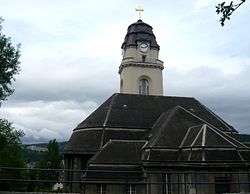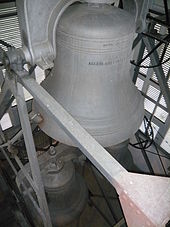Friedenskirche (Aue cell)
| Friedenskirche Aue cell | |
|---|---|
|
Friedenskirche on the Zeller Berg |
|
| Construction year: | 1912 |
| Architect : | Architectural firm Schilling & Graebner |
| Client: | ev. parish Aue |
| Floor space: | 35 × 35 m |
| Space: | 850 people |
| Location: | 50 ° 35 '25.8 " N , 12 ° 42' 17.9" E |
| Address: | Aue-Bad Schlema, Kantstrasse 2 Saxony , Germany |
| Purpose: | Evangelical Lutheran; church service |
| Website: | www.aue-zelle.de |
The Evangelical Lutheran Church of Peace in the Aue ( cell ) district of the large district town of Aue-Bad Schlema is a large Art Nouveau church in the Saxon Ore Mountains region .
history
After the church of Klösterlein cell , which had been used as the parish church of the parish in the 16th century, had become too small for the growing population, the parish council of the Evangelical Lutheran parish left Klösterlein-cell on the slope of the Zell mountain Build a new house of worship in a dominant location. An Auer entrepreneur donated the appropriate building plot to the parish. The Friedenskirche was designed in 1907 by the Dresden architects Rudolf Schilling and Julius Graebner and built from 1912 to 1914. Of the 270,000 marks construction costs, 35,000 marks were raised with donations from private individuals and companies. The larger sum came from the parish, which took out a loan for it.
On New Year's Eve 2007, several young people shot at the Friedenskirche with fireworks and penetrated the building through a damaged window. By burning further fireworks inside the church were u. a. Altar, baptismal font, acoustic system and lighting badly damaged.
architecture
The transverse centralized system was designed according to the baroque model. Several doors framed with sculptures lead into the interior from the four sides. The north-west and south-east entrance doors are clad with stylized ornaments on sheet copper, above which there are reliefs depicting Christ. Stone reliefs of the symbolized four evangelists look down from the outer pillars between the large church windows .
The sturdy church tower rises above the vestibule flanked by stairwells.
Tower with bells and clock
The 50 meter high tower ends at the top with a stepped, butt terminating copper dome and a six meter high tower cross. In 2002 the tower cross was renewed and the hood was newly covered with 0.8 millimeter thick copper sheet by two local companies.
Traditionally, an illuminated wooden cross is placed on the tower during Advent , which can be seen from afar in the city. The Christmassy Auer " tower blowing " has been going on from the Friedenskirche since the 1950s .
The ringing consists of three steel bells that were cast by the Bochumer Verein in 1913 and financed by the city of Aue with 10,000 gold marks. It is considered the most important bell in the wider area.
| No. | Ø (mm) | kg | Chime | inscription | |
|---|---|---|---|---|---|
| 1 | Little bell | 1450 | 2100 | d ' | Everything has its time, God's love forever! |
| 2 | Medium bell | 1770 | 3250 | h ° | Jesus accepts sinners! |
| 3 | Big bell | 2100 | 5010 | g sharp ° | Only God in the heights be honor , opposite the Auer city coat of arms |
The little bell is rung every morning, noon and evening.
The church clock has the largest clockwork in the city and the wider area. It was built by the company JF Weule from Bockenem .
Interior of the church
The light-flooded oval interior is artistically sophisticated in moderate Art Nouveau . The stucco ceiling, suspended from hundreds of steel cables, is designed as a 15 meter high dome in the center. On three sides of the interior there are single-storey galleries with baroque parapets on steel girders clad with sheet metal. The stained glass windows by Karl Schulz from Dresden show scenes from the New Testament . Metal work for the candlesticks and the back wall of the altar complete the church decoration.
Sanctuary
The slightly raised chancel is structured with pilasters and decorated with eight oil paintings by Bernhard Müller from Dresden. These depict Martin Luther translating the Bible, Moses with the tablets of the law, Matthew , Peter with the symbolic key, John with stole and chalice , Paul with sword, Isaiah with a scroll and Melanchthon as a doctor of the church.
The choir screens are made of black marble , the simple cafeteria with a towering altar cross is made of white marble. The two candelabra on the altar wall are valuable metal ornaments by the Wellner company , which symbolize a burning bush . The round dome of the baptismal font made of green marble is decorated with baptized children, the lid is crowned by four floating angels. On the wall behind it the young Jesus is depicted in a temple. This figure's head was cut off during the Nazi era because it "didn't look Aryan enough". After the war she got a new head.
The parapet of the pulpit is covered over the entire surface with mosaics made of polished gemstones . In the Byzantine style, symbols such as the cross, the grape, the chalice, candlestick, dove, crown of thorns , ears of corn and anchors are ornamentally incorporated.
Windows, wall and ceiling decorations
The windows on one side of the gallery show the crucifixion and mourning, the other the resurrection and the new beginning of life. Stucco reliefs on the gallery balustrade show Art Nouveau angels without wings. To the side of the chancel is a hinged war memorial for the 172 of the Evangelical Lutheran parish of Aue -zelle who fell in World War I. The panels contain the names of the dead, the flaps are decorated with a Pietà on the outside , the mother of Sorrows who mourns her dead son.
The ceiling lights were also manufactured by the Au company Wellner. With a triangle, ears of wheat and wine, the stucco ceiling gives symbolic references to the eye of God and the Trinity and Holy Communion .
organ
The organ with 33 registers on two manuals and a pedal was built for this church in 1914 by the brothers Emil and Bruno Jehmlich . Your Art Nouveau prospectus is decorated with four slender women making music. The carvings come from the Dresden sculptor Viehweg . The organ was renovated in 1996/97 by the company Vogtländischer Orgelbau Thomas Wolf .
Plaster scratch image
In the anteroom of the mezzanine floor there is a true-to-original copy of a plaster scratch painting from the 13th century, which was discovered in 1881 on the east wall of the church of the little monastery cell and is now exhibited in the monastery Altzella . The copy available here was made by Heinz Beck in 1967 .
Church life
In addition to the Friedenskirche, the parish also conducts services in the Aue Clinic and in the nursing home on the Zeller Berg. The parishioners and other interested parties can participate in the church choir, in the flute group or in the trombone choir. In addition to the usual church offers such as baptisms, confirmations, weddings or confessions, discussion, learning and prayer groups as well as community excursions are held for children, young people and families.
Web links
Individual evidence
- ↑ a b c website "The Evangelical Lutheran Church of Peace in Aue -zelle" , accessed on February 12, 2016
- ↑ Police Saxony: Devastation in Friedenskirche cleared up (message from January 10, 2008) ( Memento from April 11, 2008 in the Internet Archive ), accessed on December 14, 2008, updated on September 15, 2012
- ^ Report of the pastor on May 16, 2009.
- ^ Vogtland organ building ; here you can also find the disposition of the organ.
- ↑ Church messenger of the Evangelical Lutheran parish Aue Cell , April-May 2009 edition
swell
- Georg Dehio: Handbook of the German art monuments Saxony : II. Administrative districts Leipzig and Chemnitz. Deutscher Kunstverlag, Munich 1998, p. 31f.








